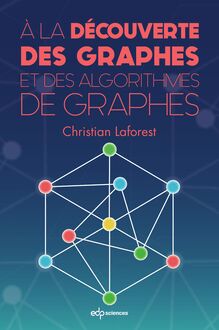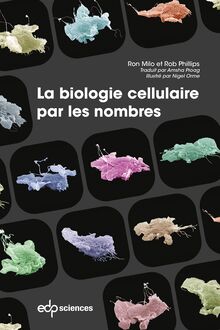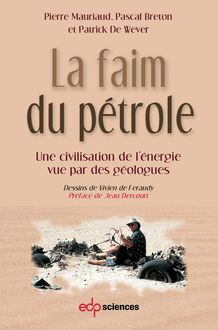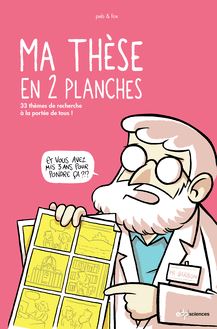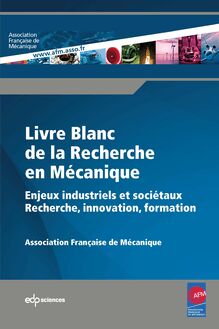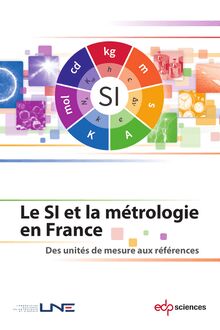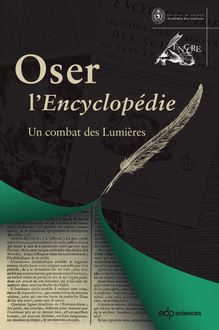The amazing history of element names , livre ebook
274
pages
English
Ebooks
2020
Obtenez un accès à la bibliothèque pour le consulter en ligne En savoir plus
Découvre YouScribe en t'inscrivant gratuitement
Découvre YouScribe en t'inscrivant gratuitement
274
pages
English
Ebooks
2020
Obtenez un accès à la bibliothèque pour le consulter en ligne En savoir plus
Publié par
Date de parution
26 octobre 2020
Nombre de lectures
3
EAN13
9782759824977
Langue
English
Poids de l'ouvrage
18 Mo
What is the connection between planet Mars and Iron Man, nickel and the Seven Dwarves, or DNA, walnuts and Jupiter, fuchsine, the fox and Zorro, or even ammoniac and the god Amun?
This book tells the stories behind the naming of the elements, whether they are chemical elements of the Periodic Table, first published by Mendeleev in 1869, or organic elements which are components of DNA and RNA, as well as proteins, themselves elements of living kingdom, plants and animals. The book goes further, into materials and products which became essential elements of modern life.
Readers will learn that the names often refer to (or reveal) dreams and aspirations of men and women of their time. This truly amazing history of the names guides us through an incredible set of worlds: nature, astronomy, history, literature, journeys, and even takes in contributions from legends and mythology.
Publié par
Date de parution
26 octobre 2020
Nombre de lectures
3
EAN13
9782759824977
Langue
English
Poids de l'ouvrage
18 Mo
Pierre Avenas
with the collaboration of Minh-Thu Dinh-Audouin
Preface by Professor Jacques Livage
The amazing
history
ofelement
namesPierre Avenas
with the collaboration of Minh-Thu Dinh-Audouin
Preface by Professor Jacques Livage
The amazing history
of element names
translated from La prodigieuse histoire du nom des éléments
with the collaboration of Alan Rodney By the same author
On polymers:
• Mise en forme des polymères. Approche thermomécanique de la plasturgie, with
thJ.-F. Agassant, J-Ph. Sergent, B. Vergnes and M. Vincent, Lavoisier, 4 ed. 2014
st(1 ed.1982), preface by Pierre-Gilles De Gennes.
• Polymer processing. Principles and modeling, with J.-F. Agassant, P.-J. Carreau,
nd stB. Vergnes and M. Vincent, Hanser Publishers, 2 ed. 2017 (1 ed. 1991).
• Et ymology of main polysaccharide names, Chap. 2 of The European
Polysaccharide Network of Excellence (EPNOE), Research initiatives and results, P. Navard (ed.),
Springer, 2012.
Etymology books:
With Henriette Walter, published by Robert-Laffont:
• L’étonnante histoire des noms des mammifères. De la musaraigne étrusque à la
nd stbaleine bleue, 2 ed. 2018 (1 ed. 2003), republished in 2 vol., « Le goût des mots »,
Points: Chihuahua, zébu et Cie, 2007, and Bonobo, gazelle et Cie, 2008.
• La mystérieuse histoire du nom des oiseaux. Du minuscule roitelet à l’albatros
géant, 2007.
• La fabuleuse histoire du nom des poissons. Du tout petit poisson-clown au très grand
requin blanc, 2011.
• La majestueuse histoire du nom des arbres. Du modeste noisetier au séquoia géant, 2017.
With the collaboration of Minh-Thu Dinh-Audouin, published by EDP Sciences/SCF:
• La prodigieuse histoire du nom des éléments, 2018.
Design and layout: CB Defretin, Lisieux
Infography: Minh-Thu Dinh-Audouin
Printed in France
ISBN (print): 978-2-7598-2464-9
ISBN (ebook): 978-2-7598-2497-7
"La prodigieuse histoire du nom des éléments" was originally published in French in 2018 by
EDP Sciences.
This work is subject to copyright. All rights are reserved, whether the whole or part of the
material is concerned, specifically the rights of translation, reprinting, re-use of illustrations,
recitation, broad-casting, reproduction on microfilms or in other ways, and storage in data
bank. Duplication of this publication or parts thereof is only permitted under the provisions of
the French Copyright law of March 11, 1957. Violations fall under the prosecution act of the
French Copyright law.
© EDP Sciences, 2020Ce n’est point en resserrant la sphère de la nature et en la
renfermant dans un cercle étroit qu’on pourra la connaître ; ce
n’est point en la faisant agir par des vues particulières qu’on saura
la juger ni qu’on pourra la deviner ; ce n’est point en lui prêtant
nos idées qu’on approfondira les desseins de son auteur. Au lieu
de resserrer les limites de sa puissance, il faudra les reculer, les
étendre jusque dans l’immensité ; il ne faut rien voir d’impossible,
s’attendre à tout, et supposer que tout ce qui peut être, est.
Buffon, Histoire naturelle
It is not by tightening the sphere of nature and enclosing it in a
narrow circle that we will be able to know it; it is not by making it
act by particular views that we will be able to judge it nor guess it;
it is not by lending it our own ideas that we will be able to deepen the
designs of its author. Instead of tightening the limits of its power,
we must push them back, extending them into the immensity; we
must not see anything as impossible, we must expect everything,
and suppose that everything that can be, is.
Buffon, Histoire naturelle
IIIChapter – Pr eface
Preface
THE AMAZING HISTORY OF ELEMENT NAMES
Year 2019 was declared as the International Year of the Periodic Table of
the Chemical Elements by UNESCO. It was indeed 150 years ago that
Mendeleev published his famous Periodic Table bringing together the
63 chemical elements already known at that time. The 118 elements
known today perfectly fit together, including the empty spaces left by
Mendeleev. It was therefore useful to recall the history of this table and
the origin of the names of the chemical elements. This is what Pierre
Avenas has done, already well-known for the etymological articles he
published in L’Actualité Chimique, the journal of the French Chemical
Society. A priori, such an opus could have been a simple enumeration
of the elements classified according to their alphabetical order or by
the date of their discovery. But actually this book, based as it is on
the etymological origin of the names, takes us through a real odyssey
of mineral, living and even thinking matter. He shows us how the
whole history of Humanity lies behind the simple denomination of
the chemical elements, from the four elements of Empedocles to the
recently discovered radioactive elements. Moreover, the term element
does not apply only to the atoms of the Periodic Table. It also applies
to the molecules that build living matter. The names of the chemical
elements come from very diverse origins. They most often do not come
from the simple field of chemistry and are inspired by other scientific
or cultural fields.
The Periodic Table of elements reveals Mendeleev’s genius. It is
undoubtedly one of the most beautiful manifestations of the human
spirit. At that time, only 63 elements were known, characterized by
their mass and chemical properties. Atoms, each with its nucleus and
electronic layers, had not yet been discovered by Niels Bohr. How was
it then possible to classify the known chemical elements, leaving empty
spaces for those which would be discovered later?
IVThe amazing history of element names
The book naturally starts with the four elements suggested by
Empedocles (fire, air, water and earth) on which the description of
thmatter was based until the 18 century. It reminds us of the basic role
of metals in the history of mankind, from the Bronze Age to the Iron
Age! The book then takes us to other horizons, such as mythology,
history or geography. It shows us which people, beliefs or circumstances
inspired the name of each element. We thus cover the entire history
of mankind, from the pigments used in parietal wall paintings to very
recently discovered radioactive elements. The elements, which in fact
constitute all the living and inanimate matter of the Universe, play a
basic role in our history. Far beyond simple chemistry, Pierre Avenas
opens up a vast horizon in which sciences, history and humanities are
closely intertwined.
Jacques Livage
Professor at the Collège de France
Member of the French Académie des Sciences
VChapter – For eword
Foreword
THE AMAZING HISTORY OF ELEMENT NAMES
Year 2019 was proclaimed by UNESCO the
“International Year of the Periodic Table of Chemical Elements”.
This theme is more familiar than it sounds in scientific terms, since
we use the names of chemical elements every day, such as the oxygen
we breathe or the helium we use to inflate balloons. Gold and silver
are also chemical elements, as are copper or iron and numerous other
metals. Some elements are known to be beneficial to health, such as
phosphorus for the brain functions, fuorine for our teeth, sulphur
for our hair... and others are known as trace elements, such as iodine or
selenium. And everyone knows that table salt is sodium chloride, where
two elements, chlorine and sodium, combine. Finally, let’s mention
the field of energy, where we are constantly talking about carbon, but
also photovoltaic silicon and uranium as used in nuclear power plants.
We can see that a great many chemical elements are no strangers to us.
Today, 118 of them have been identified, 90 of which are natural on
Earth, where they make up the totality of matter, i.e., including the
mineral or living kingdoms. The elements combine in the countless
substances and compounds that surround us, many of which are part
of daily life.
zAn approach based on etymology...
This book is a collection of articles, known as “clins d’œil étymologiques”
(“etymological winks”), published since 2012 in L’Actualité Chimique,
1a journal of the Société Chimique de France (SCF), French Chemical
Society. The basic, underlying idea is to present the etymological
1. www.societechimiquedefrance.fr
VIThe amazing history of element names
origin of the names of substances, whether they be chemical elements
or compounds such as starch, brass or plexiglas.
But that’s not all, the aim of the book goes far beyond that.
z ... and that leads to worlds that are sometimes
unsuspected
Indeed, the etymology of a name often tells us a great deal about
the discovery of the substance evoked, about the research scientists
involved, and even about the state of science at the time of discovery.
A whole history that quickly led us on to other scientific or cultural
fields such as botany and zoology, astronomy, history and mythology,
medicine and biology, technology and industry...
Names that make people travel, if only because they are given in
English, French and often in Spanish and German. Both the chapter
titles and the illustrations give free rein to the reader’s imagination.
But the aim of the book is also to make the Periodic Table more
familiar, as highlighted in the theme of the year 2019.
z From the list of elements to the Periodic Table
In 1789, Lavoisier established the concept of the chemical element and
his Traité élémentaire de chimie listed 23 elements known at that time.
Later on, other elements were discovered, classified by mass from the
lightest, hydrogen, to the heaviest, uranium. And, taking into account
their properties, they were arranged in a table with several columns.
And it was a graduate from the French engineering school École
Polytechnique, Alexandre de Chancourtois (1820-1886), who was
the first to introduce periodicity in this classification, in 1862, in the
original form of a helix traced on a cylinder, the so-called Telluric scr
